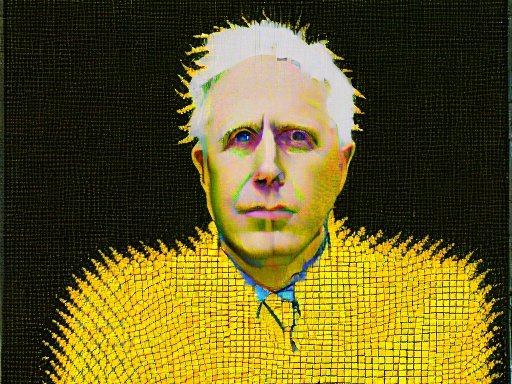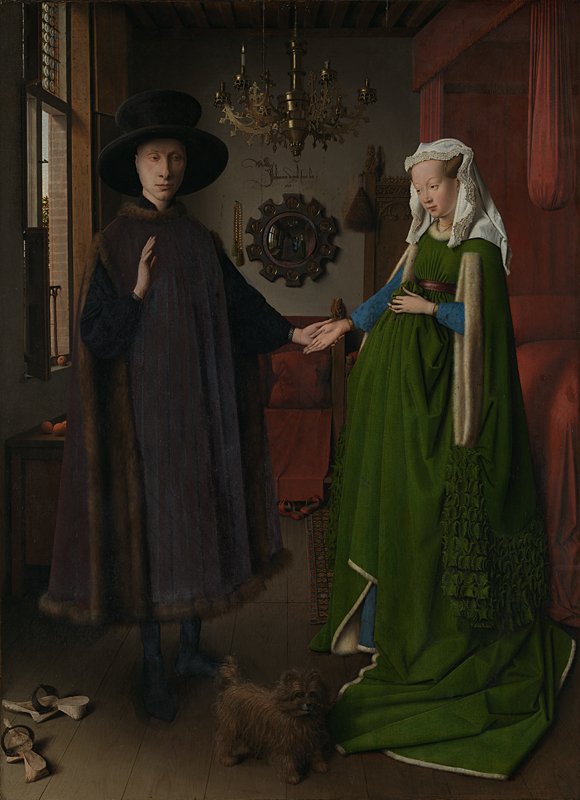The Mirror and the Lens
Image created by the author using the Stable Diffusion text-to-image generation tool.
This article is the first in a series on Generative Artificial Intelligence (AI) and creativity. Generative AI is a new type of artificial intelligence that’s able to create new, original content from user generated prompts. It can create original images, music, literature, computer code, product designs, drugs, and more. While I’ll briefly discuss how Generative AI tools work in upcoming posts, I won't go into a lot of detail. There are many informative articles and videos on this subject for non-technical readers that do a good job of explaining the foundational concepts and technologies. I'll include a few links to recommended resources at the end of each post.
I'm beginning the series with thoughts on the Old Masters' use of mirrors and lenses, and the invention of photography, to place Generative AI into the larger context of the deep, ongoing relationship between art and technology. In the next issue, I'll focus on Generative AI image creation tools, including OpenAI’sDalle-2 and Stability AI’s Stable Diffusion. Then, I’ll turn to text generation tools, including ChatGPT. I’ll close the series by exploring ways to integrate these tools into your creative workflow. Along the way, I’ll touch on how these tools affect our understanding of creativity, how they impact the creative process itself, and the new skills creatives need to develop in the emerging age of Generative AI.
Fabricating Pictures
How do you see the world? The literal answer is that you see through your two eyes. But it's not that simple. The pictures of the world you carry in your head are fabrications assembled from what you see with your unaided vision and what you see through the myriad lenses that alter what you see with your naked eyes. From the lenses in the glasses and contacts many of us wear to "correct" our vision, to the enhancement lenses in common tools such as magnifying glasses, binoculars, microscopes, telescopes, and the more advanced imaging systems in tools such as thermal imaging scopes, infrared scopes, night vision scopes, X-rays, CT scans, and MRIs, how we see and what we see is augmented by technology.
Generative AI, and especially generative image creation tools, are something new. But the connection between image making and technology is not new. In fact, it’s older than we’ve previously believed.
The Old Masters
Have you ever looked at a painting by Da Vinci, Holbein, Caravaggio, Vermeer, Rembrandt, Velasquez, Ingres or one of the other Old Masters and wondered how they achieved the realistic effects that give their paintings such a strong sense of realism? If so, you’re not alone. There have always been hints that from the early fifteenth century on, Western artists used mirrors and lenses (“optics”) to create live projections that helped them produce more realistic drawings and paintings. But concrete evidence of their use has been elusive. If the Old Masters used optics, the tools and techniques remained secret knowledge.
The painter David Hockney also wondered whether the Old Masters used optics, and if so, how their use affected the development of painting. To answer these questions, Hockney organized hundreds of high-quality color reproductions of portraits into what he called his “Great Wall”—five centuries of Western portraiture, from “pre-optic” portraits in Byzantine mosaics to an 1889 Post-Impressionist portrait by Vincent Van Gogh. The portraits were arranged chronologically on the horizontal axis and geographically on the vertical axis. This allowed him to track the development of specific visual effects and styles as they evolved over time from country to country.
What Hockney discovered over the course of the two years he dedicated to studying the images on his wall is that the use of mirrors and lenses was far more widespread than previously known. Working with art historians, scientists, and friends, he was able to show that Renaissance artists used curved mirrors and lenses as they worked to develop perspective and the treatment of light and shadows that create a sense of depth (chiaroscuro). He also developed compelling evidence that the camera obscura (a device that projects images in a darkened room) and the camera lucida (a device that superimposes an image of the subject being viewed on the surface the artist is drawing on) were instrumental in the development of photographic realism in portraiture.
Hockney believes the first verifiable evidence of the use of optics appears in a 1430 portrait by Jan van Eyck, Portrait of Giovanni Arnolfini and His Wife:
© The National Gallery, London
In his chronicle of his study, Secret Knowledge: Rediscovering the Lost Techniques of the Old Masters, Hockney draws our attention to the convex mirror on the back wall. He writes, “If you were to reverse the silvering, and then turn it around, this would be all the optical equipment you would need for the meticulous and natural-looking detail in the picture.” He adds:
The chandelier has always fascinated me. It was done without any detailed underdrawing or corrections (it's the only object in the picture to have been painted like that), amazing for such a complicated foreshortened form. Van Eyck could have hung the panel upside down next to the viewing hole and painted it directly, following the form he could see on the surface. Notice how the chandelier is seen head on (not from below, as you would expect). This is the effect you would expect with a mirror-lens, which must be level with the objects you want to draw or paint. It would have been a superb subject to show off his skills. Artists think of these things.
It takes an artist to decode the secrets of another artist… Hockney's findings challenge popular notions of what it means to be an artist. Some artists, scholars, and friends were horrified by his claims. For them, artists who used optical aids were cheating. They believed Hockney was attacking the idea of innate artistic genius. But Hockney counters:
... to an artist six hundred years ago optical projections would have demonstrated a new vivid way of looking at and representing the material world. Optics would have given artists a new tool with which to make images that were more immediate, and more powerful. To suggest that artists who used optical devices, as I am doing here, is not to diminish their achievements. For me, it makes them all the more astounding.
To be clear, Hockney is not suggesting that the artists who used optical devices projected a whole picture then simply traced what they saw. He believes they used the devices to make a “collage of elements pieced together very, very cleverly, very creatively.” They used lenses to help clarify and realize their vision for their paintings—they used them to help their eyes see what was already clear in their imagination and mind.
Certain types of images (such as self-portraits) are impossible to capture without some sort of reflective surface. The mirror reflects both the artist's image and their surroundings. The lens brings the visible world into focus in ways that transcend the capabilities of the naked eye—it enables us to see what we can’t see on our own. Both the mirror and the lens are essential to the creative process. In combination, the mirror and the lens enable us to see and study the visual world around us—to dissect, manipulate, recreate, and capture it.
Pictures on Silver
On January 7, 1839, Louis-Jacques-Mandé Daguerre introduced his first camera and the images it had captured to the French Académie des Sciences. The images weren’t initially called “photographs” or even “daguerreotypes” (the clever term Daguerre later introduced to brand and market his photographic process)—the members in attendance at the meeting referred to them as “pictures on silver.” This distinction matters because the word “picture” is a general term that refers to a design or image captured on a surface.
Daguerre's images were initially thought of as images captured on a silver plate, just as a painting is an image captured on paper, canvas, wood, or another type of surface. As capturing images with Daguerre’s device and the devices of other inventors became more popular, the language for describing and categorizing the images captured with these devices multiplied—from the daguerreotype, to the calotype, cyanotype, stereograph, albumen print, wet collodion print, ambrotype, tintype, silver gelatin print, and the snapshot—following George Eastman’s introduction of the Kodak 1 box camera in 1888.
We are at the beginning of the age of pictures created with Generative AI. We haven’t developed the language we need to differentiate between the many types of images AI assisted image creation will enable. It’s possible the pictures developed using Generative AI will seamlessly blend into our general concept of a picture, or not... One thing we know for sure, Generative AI image tools enable a new form of picture making. It’s too early to tell whether we will develop commonly understood ways to distinguish between the processes AI systems use to generate images—or whether one type or style of AI generated image will be so widely embraced that its name will work its way into our language.*
There’s another aspect of the invention and growth of photography that’s important to note: Initially, photography was a disruptive technology. Because photographs represent reality more accurately than paintings or drawings, and do so with less time and effort than paintings, photography quickly became the preferred way to produce portraits. Photographs were also significantly less expensive than paintings and quickly became prized possessions in the homes of those who could afford them.**
While photography diminished the demand for portrait paintings (an important source of revenue for professional artists at that time), it freed visual artists from the need to be realistic. Photography opened the door to the looser style of Impressionism and the increasingly abstract forms of paintings that followed.
The next article in this series will focus on Generative AI creation tools. As you’ll learn, these tools are a new kind of mirror and lens. They reflect the patterns that run through our collective visual culture back to us through the lens of the words we use to describe our creative concepts. We are at the beginning of a fascinating new era of creative expression.
Footnotes
* Such as the original meaning of “a Kodak moment:” A sentimental or charming moment worthy of capturing in a photograph.
** In 1842, the cost of a daguerreotype portrait was about $125. By 1870, the cost for a tintype portrait was about 5 cents, or a little over $1 today.
Recommended Resources
How Generative AI Is Changing Creative Work, Harvard Business Review
The Dawn of Artificial Imagination, The Atlantic
When AI Can Make Art—What Does It Mean for Creativity, The Guardian
NeoLucida (For those interested in playing with a modern reinterpretation of the camera lucida.)


